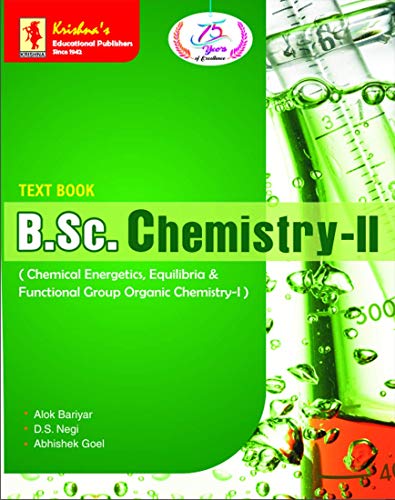Product desciption
Krishnas Chemical Energetics Equilibria Functional Group Organic Chemistry by , B092699GGD instant download after payment.
SYLLABUS- CHEMICAL ENERGETICS, EQUILIBRIA & FUNCTIONAL GROUP ORGANIC CHEMISTRY-I, Section A: Physical Chemistry-1 (30 Lectures)
Chemical Energetics: Review of thermodynamics and the Laws of Thermodynamics. Important principles and
definitions of thermochemistry. Concept of standard state and standard enthalpies of formations, integral and
differential enthalpies of solution and dilution. Calculation of bond energy, bond dissociation energy and
resonance energy from thermochemical data. Variation of enthalpy of a reaction with temperature – Kirchhoff’s
equation.Statement of Third Law of thermodynamics and calculation of absolute entropies of substances.
(10 Lectures)
Chemical Equilibrium: Free energy change in a chemical reaction. Thermodynamic derivation of the law of
chemical equilibrium. Distinction between DG and DG°, Le Chatelier’s principle. Relationships between K p, Kc
and K for reactions involving ideal gases. x (8 Lectures)
Ionic Equilibria: Strong, moderate and weak electrolytes, degree of ionization, factors affecting degree of
ionization, ionization constant and ionic product of water. Ionization of weak acids and bases, pH scale, common
ion effect. Salt hydrolysis-calculation of hydrolysis constant, degree of hydrolysis and pH for different salts. Buffer
solutions. Solubility and solubility product of sparingly soluble salts – applications of solubility product principle.
(12 Lectures)
Section B: Organic Chemistry-2 (30 Lectures)
Functional group approach for the following reactions (preparations & reactions) to be studied in context to their
structure.
Aromatic hydrocarbons
Preparation (Case benzene): from phenol, by decarboxylation, from acetylene, from benzene sulphonic acid.
Reactions: (Case benzene): Electrophilic substitution: nitration, halogenation and sulphonation. Friedel-Crafts
reaction (alkylation and acylation) (upto 4 carbons on benzene). Side chain oxidation of alkyl benzenes (upto 4
carbons on benzene). (8 Lectures)
Alkyl and Aryl Halides
Alkyl Halides (Upto 5 Carbons) Types of Nucleophilic Substitution (S 1, S 2 and S i) reactions. N N N
Preparation: from alkenes and alcohols.
Reactions: hydrolysis, nitrite & nitro formation, nitrile & isonitrile formation. Williamson’s ether synthesis:
Elimination vs. substitution.
Aryl Halides Preparation: (Chloro, bromo and iodo-benzene case): from phenol, Sandmeyer & Gattermann
reactions.
Reactions (Chlorobenzene): Aromatic nucleophilic substitution (replacement by –OH group) and effect of nitro
substituent. Benzyne Mechanism: KNH2 / NH3 (or NaNH2 / NH3).
Reactivity and Relative strength of C-Halogen bond in alkyl, allyl, benzyl, vinyl and aryl halides. (8 Lectures)
Alcohols, Phenols and Ethers (Upto 5 Carbons)
Alcohols: Preparation: Preparation of 1° , 2° and 3° alcohols: using Grignard reagent, Ester hydrolysis, Reduction of
aldehydes, ketones, carboxylic acid and esters.
Reactions: With sodium, HX (Lucas test), esterification, oxidation (with PCC, alk. KMnO4, acidic dichromate,
conc. HNO3 ). Oppeneauer oxidation Diols: (Upto 6 Carbons) oxidation of diols. Pinacol-Pinacolone
rearrangement.
Phenols: (Phenol case) Preparation: Cumene hydroperoxide method, from diazonium salts. Reactions:
Electrophilic substitution: Nitration, halogenation and sulphonation. Reimer-Tiemann Reaction, Gattermann-Koch
Reaction, Houben–Hoesch Condensation, Schotten – Baumann Reaction.
Ethers (aliphatic and aromatic): Cleavage of ethers with HI.
Aldehydes and ketones (aliphatic and aromatic): (Formaldehyde, acetaldehyde, acetone and benzaldehyde)
Preparation: from acid chlorides and from nitriles.
Reactions – Reaction with HCN, ROH, NaHSO3, NH2 -G derivatives. Iodoform test. Aldol Condensation,
Cannizzaro’s reaction, Wittig reaction, Benzoin condensation. Clemensen reduction and Wolff Kishner
reduction. Meerwein-Pondorf Verley reduction. (14 Lectures)


